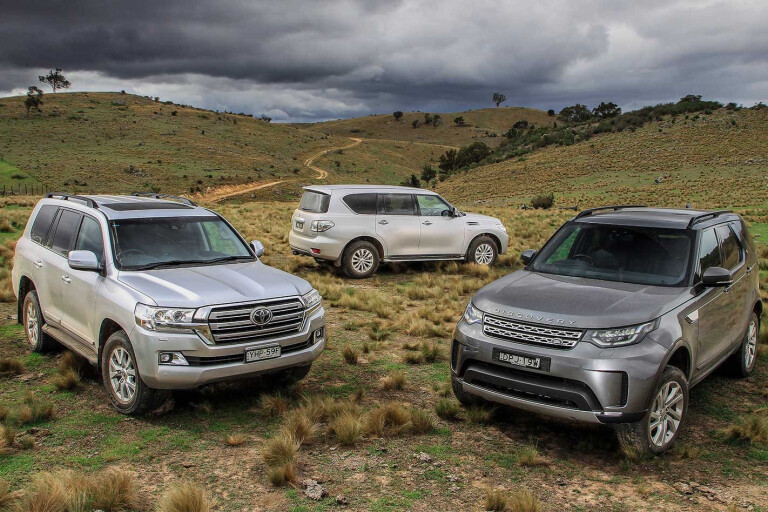
Toyota's Land Cruiser 200 Series is a decade old but is selling more strongly than ever after a boost in sales, especially the more expensive VX and Sahara models that followed the 2016 model-year upgrade.
That upgrade brought a major restyle to the front end, including a distinctive scalloped bonnet, new headlights and grille, new rear styling, and extensive equipment upgrades right across the four-model range – particularly to the VX and Sahara. That 2016 upgrade also saw the 4.5-litre V8 diesel fitted with a particulate filter (for Euro 5 emissions compliance) and gain an extra 5kW to bring it up to 200kW, with maximum torque remaining at 650Nm.

However, if you don’t want a 200 Series, what are the affordable options for a large, off-road-capable wagon with at least seven seats? Well, not much really, only the Land Cruiser’s longstanding rivals: the Nissan Patrol and the Land Rover Discovery.
The Patrol in question is the Y62, which has been around in Australia since 2012 and is only available with a petrol engine. The Discovery, on the other hand, is diesel-only and all-new.
If Land Rover had stuck to its time-honoured naming system it would be a Discovery 5, but even that badge would be a little confusing, as this new Discovery is only the third all-new Discovery since the original appeared in 1989.
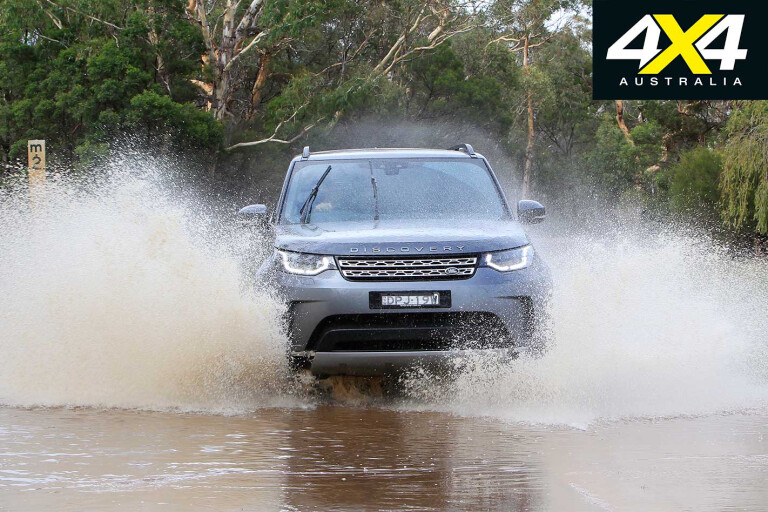
In the current market, both the Discovery and the Patrol are relatively unloved compared to the Land Cruiser, but do they deserve to do better?
LAND ROVER DISCOVERY TD6 - Light is Right
Thanks largely to its Range Rover DNA, the new model brings technical sophistication never before seen in a Discovery.
"Welcome to your flight,” you may think when climbing aboard this Discovery. You see, this new-generation Discovery is fabricated not from steel but largely from lightweight aluminium – much like aircraft – using processes developed in the aircraft and aerospace industry. It also has a body honed in a wind tunnel, influenced greatly by aerodynamics.
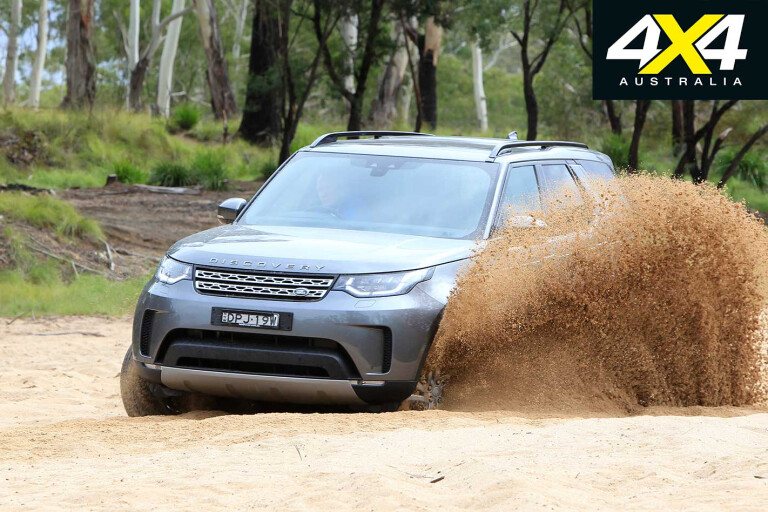
The body is the main structure with no separate chassis, as there has been with all previous Discovery models. That technically makes it a monocoque; although, the structure still comprises many different elements, and while 85 per cent of it is aluminium – both pressed and extruded – it also includes magnesium (which is even lighter than aluminium) in the nose structure, composite in the tailgate, and steel (for durability) in the suspension subframes.
Why go to all this bother? The answer is simple: to save as much as 480kg over the previous Discovery, which was built from steel and on a separate chassis. Less weight means stronger performance, sharper handling, quicker braking, improved fuel economy and superior off-road ability, especially on soft surfaces like sand and mud.
POWERTRAIN AND PERFORMANCE
The new Discovery comes with three engines in Australia: two four-cylinder diesels and a V6 diesel, as tested here.
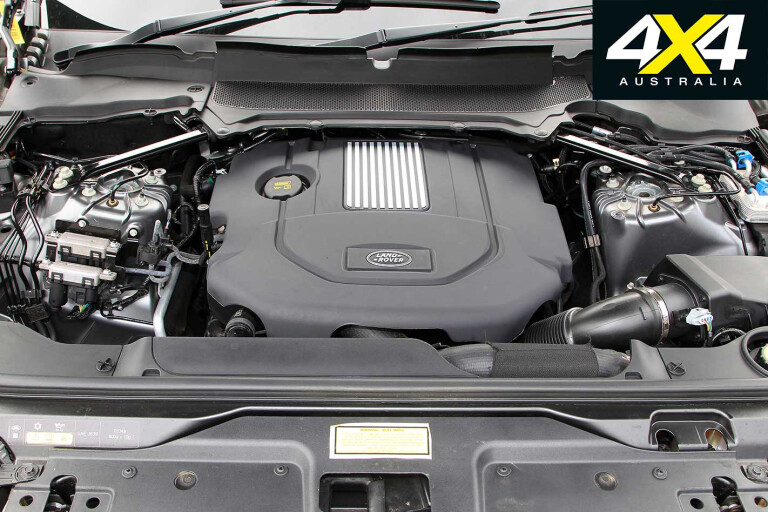
The V6 is the most expensive and powerful of the three and has been developed from the V6 in the Discovery 4. But where that engine had two turbos the new engine utilises a simpler single-turbo design. However, that doesn’t stop it claiming more peak power (now 190kW, up from 183kW) and the same maximum torque of 600Nm.
Those sort of numbers aren’t lost on what’s a very light vehicle for its size and bring effortless cruising and plenty of top-end zing in what’s a surprisingly revvy, but still quiet and refined engine. Thanks in part to its eight-speed automatic, the Discovery has more zip than the relatively lazy 4.5-litre V8 diesel in the 200, which also has to deal with 500kg more weight.
The Discovery’s weight advantage and aerodynamically shaped body also help it achieve the best fuel economy here – 2.0L/100km better than the 200 and 7.0L/100km better than Patrol. The Discovery’s V6 is also far more quiet and refined than the 200’s diesel; although, neither diesel can match the Patrol’s V8 in terms of refinement or punch.
ON-ROAD RIDE AND HANDLING

Weight, or rather the lack of it, is also the defining element of the Discovery’s on-road dynamics. It is 500kg lighter than the 200 and some 600kg lighter than the Patrol, but it also has another trick up its sleeve compared to these behemoths, namely its height-adjustable air suspension.
As it can be jacked up for off-road use, the default on-road ride height is relatively low for improved stability and agility and is automatically lowered further at higher speeds. The driver can also manually select the lower height at speeds below the automatic engagement.
Throw in its beautifully weighted electric power steering and the road-oriented tyre spec and the Discovery feels like a darty go-kart on tight, winding roads compared to either the 200 or the Patrol, both of which are cumbersome in comparison; although, still notably different to each other.
The only negative is the Discovery’s ride on the 20s, as fitted to this HSE. The ride isn’t generally harsh by any means, but it lacks the plush feel of the 200 in particular and also the Patrol at lower speeds on rough roads.
OFF-ROAD

The Discovery’s height-adjustable suspension is its number one party-trick off-road. The fact you can jack it up so far means it will go down a rocky trail without dragging its well-protected undercarriage.
Better still, there’s a decent amount of wheel travel – it’s especially good for a fully independent system – so even in the standard off-road position (40mm up from the default ride height) the ride quality is still good and the suspension doesn’t top-out too readily.
The long travel suspension also means less reliance on traction control, which is tuneable via Land Rover’s clever and logical Terrain Response system. However, those wanting to get the most out of their Discovery will need to select the rear-locker option, which wasn’t fitted to our test vehicle.
The Discovery’s biggest off-road failing is the standard high-speed (V, or 270km/h) rated tyres with their fragile sidewalls.
RIDING ON AIR
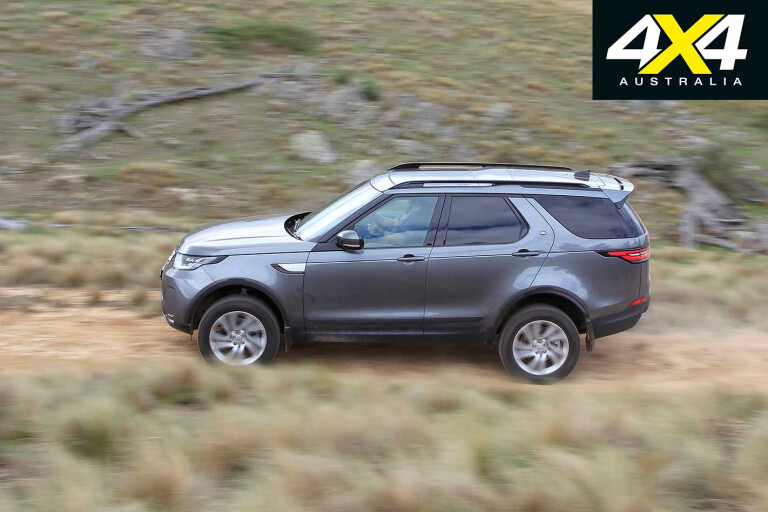
The Discovery has fully independent suspension and most models come with height-adjustable air springs, which brings benefits both on- and off-road and to day-to-day functionality.
From the default ride height of 208mm the suspension can be jacked up 75mm for off-road use in a couple of stages to give 283mm of ground clearance and an impressive 900mm wading depth.
For highway driving the suspension automatically drops by 13mm to enhance handling and aero efficiency. Access height is also 40mm below the default ride height, making it easier to get in and out of the car, load gear in and out of the car, or hook-up a trailer or caravan.
CABIN, ACCOMMODATION AND SAFETY
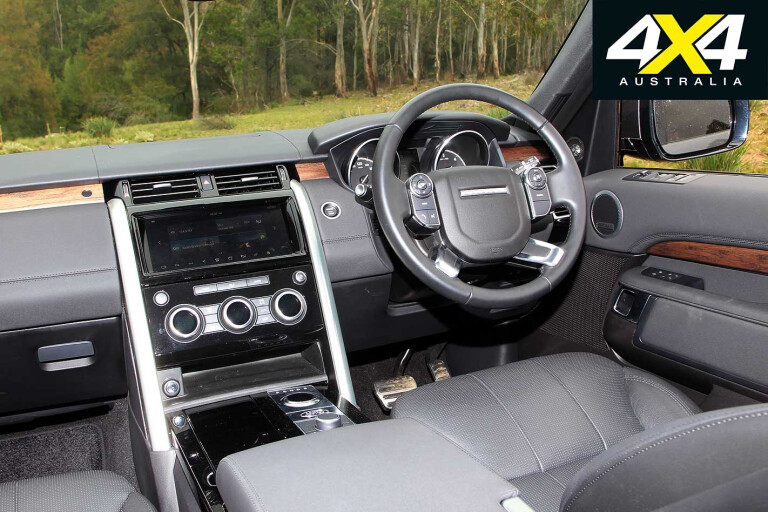
The new Discovery’s body is longer, narrower than and not as tall as the Discovery 4. The windscreen is more raked and the driving position lower and not as commanding off-road. The rear of the car is also tapered in rather than squared off, as was the case with Discovery 4, which has been done to reduce aerodynamic drag.
Inside, the Discovery feels more closed-in than the Discovery 4, and it’s smaller than the 200 and the very large Patrol. The Discovery still has the most spacious third-row seat, and there’s plenty of space and comfort up front. Although, in this company, it has the tightest middle-row seat and the least luggage space.
Not surprisingly the Discovery, being a completely new design, has a five-star ANCAP safety rating.
PRACTICALITIES

The Discovery excels on and off the road, but some of the gloss comes off in terms of practicality, especially in terms of a 4x4 tourer.
The 85-litre fuel capacity is too small despite the engine’s excellent economy, and fitting a long-range fuel tank looks difficult if not impossible.
At this stage the aftermarket doesn’t appear keen to produce a bullbar for the Discovery either, but it’s technically possible. Better news is that the Discovery is rated to tow 3500kg and has the best payload figure here.
WHAT YOU GET

The TD6 engine can be had in four equipment grades, from the bare-bones, cloth-seat $78,750 S model to the $116,800 HSE Luxury.
The S doesn’t have dual-range gearing or height-adjustable air-spring suspension, but these can be optioned on the S for $920 and $2060 respectively, or come standard with the $92,650 SE. The S TD6 can’t be optioned with the rear automatic e-locker, so if you want to go this way you have to start with an SE and add $1020 for the locker.
The SE adds leather, sat-nav, up-spec audio, LED headlights, DRLs and a factory towbar, and looks the best buy of the four equipment grades. In addition to the four specs levels there’s a huge range of options. Our test HSE, for example, starts at $103K but was loaded with $17K worth of extras.
TOYOTA LAND CRUISER 200 - The Benchmark
The 200 embodies Toyota’s design philosophy that champions simplicity and durability over technical sophistication.
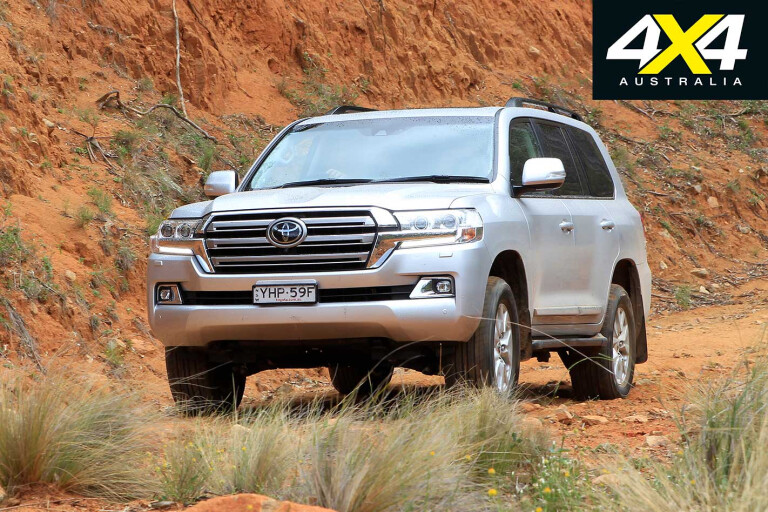
It is almost 10 years since the 200 Series arrived in Australia to replace the 100 Series. Over those 10 years the 200 has changed little, save for the introduction of the work-spec GX diesel in 2011, a new-generation V8 petrol engine in 2012, and the late-2015 styling, equipment and emission upgrade that led to its recent sales explosion.
The Land Cruiser is the oldest design here and certainly the most ‘old-school’ in 4x4 terms. The Patrol also has a separate chassis, but the 200 is the only vehicle here with a truck (or live) axle at the rear. And, apart from its KDSS suspension – effectively swaybars that can automatically tension up for on-road use and then de-tension for off-road use – there’s nowhere near the suspension trickery that you’ll find under the Patrol or the Discovery.
What we are driving is the top-spec Sahara, at $120K plus on roads it’s the most expensive vehicle here. The Sahara wasn’t our first choice – we would have preferred a GXL for better price parity – but the Sahara is still essentially the same mechanical package, except that KDSS is standard on Sahara and an extra-cost ($3250) option on the GXL.
POWERTRAIN AND PERFORMANCE
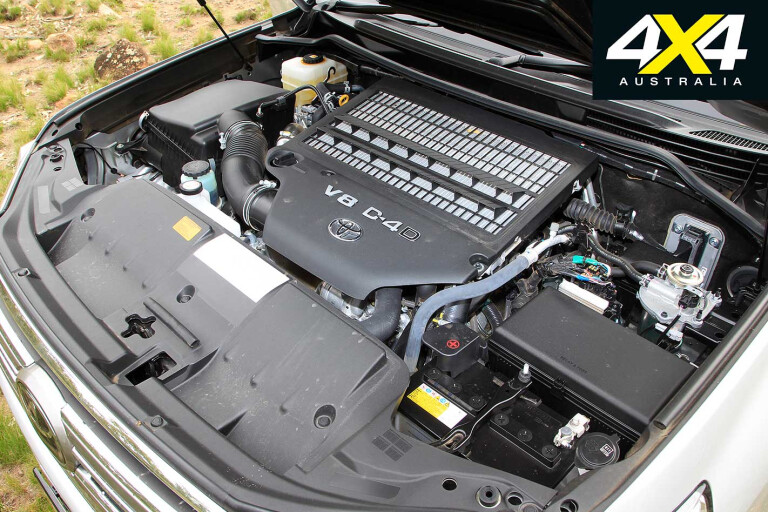
Despite gaining piezo injectors and a particulate filter as part of the late-2015 Euro 5 emission compliance, the 200’s 4.5-litre V8 diesel is relatively low-tech and under-stressed compared to most modern diesel engines. The V6 in the Discovery, for example, makes similar power and torque despite being only two-thirds the capacity.
The 200’s engine is effectively a twin-turbo version of the V8 used in the various 70 Series Land Cruisers; although, the twin-turbo system is a relatively simple parallel arrangement where one turbo serves each bank of four cylinders.
While quieter than it was before the Euro-5 compliant injection system arrived in late 2015, the 200’s V8 oiler is still noisy and gruff compared to the Discovery’s diesel, let alone the very refined petrol engine in the Patrol.
In this company it sounds and feels ‘truck-like’, and while comparisons to the Patrol’s petrol V8 may be unfair, even the Discovery tips it for performance and is in a different league refinement wise. Still, for all that, the 200’s engine is effortless and rarely has to work hard to get the job done.
ON-ROAD RIDE AND HANDLING
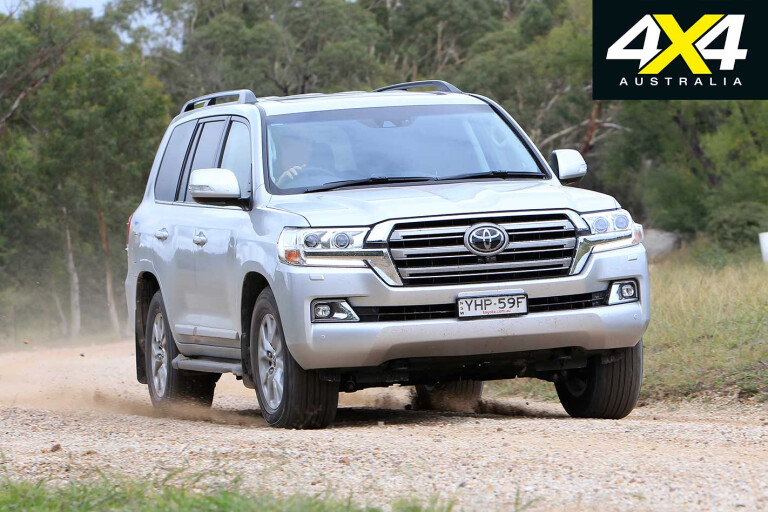
The 200 feels heavy on the road in this company, even though the Patrol weighs more. The 200’s steering is certainly the heaviest here, yet doesn’t particularly reward with feel – try to push the 200 down a winding road briskly and it’s the one that will protest the most.
Drive it fast and hard on a rough back road and you’ll also feel the sometimes unsettling nature of the rear live axle compared to the independent rear suspensions of the other two.
That’s the bad news. The good news is it has a plush and quiet ride that’s noticeably suppler than the Discovery – especially at slow speeds – and generally more compliant than the still smooth-riding Patrol.
KINETIC TWIST
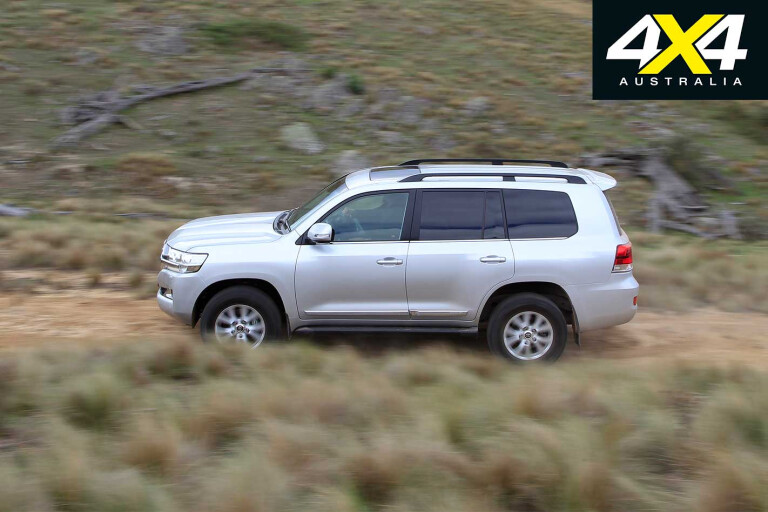
The LC200’s chassis might be old-school compared to the Discovery or the Y62, but is has one trick up its sleeve: its Kinetic Dynamic Suspension System (KDSS).
Standard on the Sahara and VX and optional on the GXL (but not the GX), KDSS is a simple yet effective means of automatically adjusting the tension on the suspension’s swaybars.
On the road KDSS automatically holds the tension on the swaybars to limit bodyroll when cornering, but off-road it allows the swaybars to relax to maximise the wheel travel. It does this via interlinked hydraulic cylinders fitted between the swaybar ends and the chassis.
OFF-ROAD

The softly-sprung long-travel suspension is the secret behind the 200’s formidable off-road ability. While the Discovery and Patrol have impressive rear-wheel travel they can’t match the 200’s live axle, even if there’s not much between them up front.
The Sahara’s full-time 4x4 system is the same as lower-spec 200s and has three open diffs, with a driver-activated lock on the centre diff. However the Sahara, like the VX, has ‘Multi-Terrain Select’, which is a take on Land Rover’s Terrain Response except that it’s only available in low range.
The various modes are also somewhat confusing with ‘Mud and Sand’, ‘Loose Rock’, ‘Mogul’, ‘Rock and Dirt’ and ‘Rock’. You would think there should at least be ‘Gravel’ and ‘Sand’ modes available in high range and simpler selection in low range. Still, the 200’s basic 4x4 attributes are so good that the MTS set-up is largely irrelevant.
CABIN, ACCOMMODATION AND SAFETY

The 200’s cabin is big and spacious and, while it shades the Discovery for space, it’s not as big as the Patrol, especially with regards to luggage space behind the third-row seat and the width of the rear seat.
The fact the third row (which seats two in the Sahara and VX rather than three as in the GXL) folds up against the side windows means a low luggage floor, which is a bonus even if the seats eat into the cargo volume.
The Sahara and the VX get 10 airbags where the GXL and GX get eight, the difference being the rear-seat side airbags; although, all 200 variants have a five-star ANCAP rating.
PRACTICALITIES
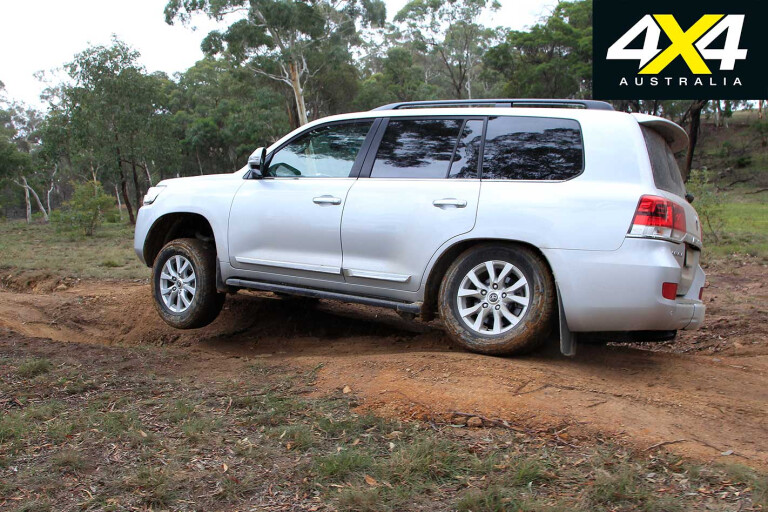
The 200 is the practicality king in this company. Thanks to its diesel engine and decent fuel capacity – a combination the other two can’t match – it has the best fuel range by far.
The 200 is also unmatched in terms of aftermarket support and comes with a practical wheel and tyre spec, even if tyres to suit the 18s on the Sahara and VX (which comes standard with V-rated rubber) aren’t nearly as readily available as tyres for the 17s on the GXL and GX. At least you can fit the 17s from the lower-spec models to your Sahara or VX.
WHAT YOU GET
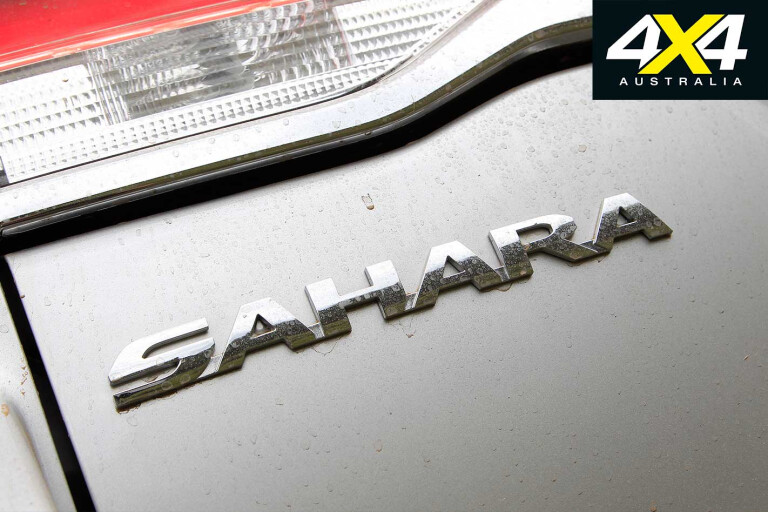
Land Cruiser 200 diesel prices start at $78,261 for the GX, the basic five-seat model with rear ‘barn’ doors, steel wheels and a snorkel.
For $10K more the GXL adds sat-nav, a reversing camera, side-steps, third-row seats, dual-zone climate, alloy wheels, and smart-key entry and stop/start. Another $10K will get the $98,881 VX, which adds leather, two additional airbags, front and rear parking sensors, auto LED headlights, auto wipers, a sunroof, KDSS, 18s and Multi-Terrain Select.
The $120,301 Sahara (as tested) then adds heated and cooled front seats, heated second-row seats, four-zone climate, rear DVD player, a cooler box, a power rear tailgate, Multi-Terrain Monitor (via external cameras) and high-end safety equipment including radar cruise, lane departure warning, blindspot monitoring and rear cross-traffic alert.
NISSAN PATROL Y62 - Petrol Head
Nissan’s Y62 Patrol struggles for sales in a world where diesels rule, but are buyers looking close enough?
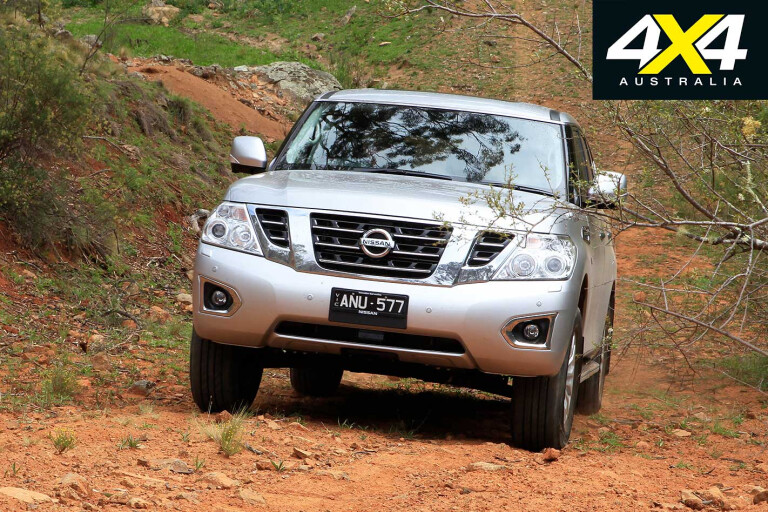
So it has come to this.
If you want a new Nissan Patrol, then it is petrol or nothing given the last of the diesel Patrols (the Y61) has been killed off by the latest Euro 5 emission regulations from last year. The Patrol you can buy isn’t a petrol version of the old Patrol but a ‘new from the ground up’ design.
However, ‘new’ in this case doesn’t mean recent, as this Patrol, the Y62, first appeared eight years ago in the Middle East and arrived here in 2012.
Ever since the Y62 first showed up there’s been talk of a diesel engine, but one hasn’t appeared and there doesn’t seem to be one on the horizon. So for now it’s petrol only.
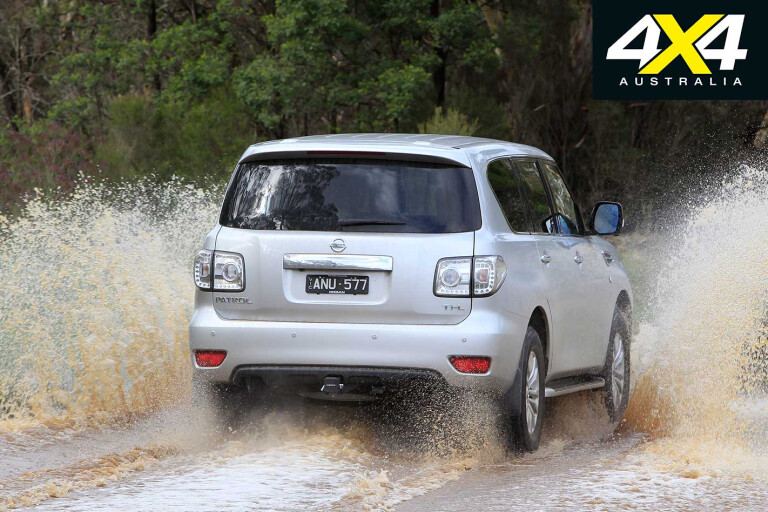
To combat slow sales in a diesel-loving market, Nissan slashed the price of the Y62 in mid-2015 by $25K, at the same time making way for the QX80, effectively an up-spec Y62 from Nissan’s luxury brand Infiniti. Those 2015 prices have more or less held since and see the Y62 priced well under a Land Cruiser 200.
The top-spec Ti-L we have here is $89K, despite offering equipment more akin to the $120K Sahara. In fact, the Ti-L is even cheaper than the relatively ‘bare bones’ GXL when optioned with KDSS, something it needs to give its best on and off the road.
POWERTRAIN AND PERFORMANCE
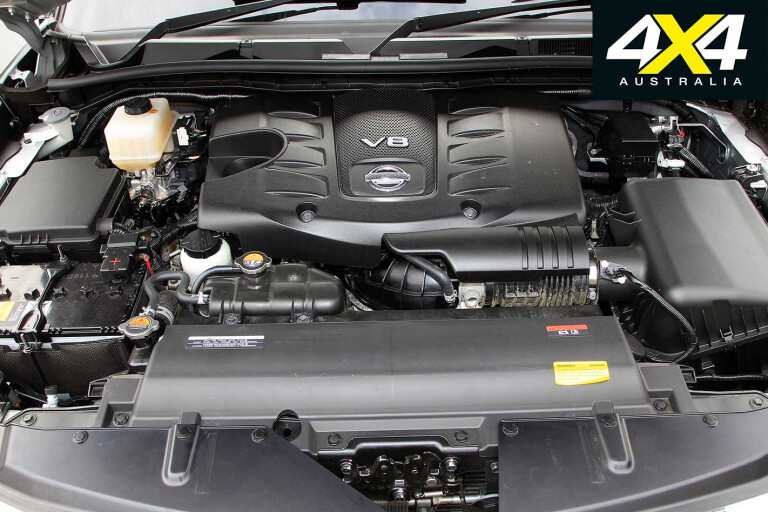
Petrol-only may be bad news for sales, but the good news is that the Y62’s 5.6-litre V8 is a cracker. For a naturally aspirated petrol engine it is state-of-the-art, with direction injection, and variable valve timing and variable valve lift on both inlet and exhaust cams.
It punches out 298kW, which is 50 per cent more – give or take a little – than either diesel here.
On the road it feels like it, too. Pedal to the metal it’s the Patrol first and daylight second. All the while the big V8, which hails from an engine family widely used in motorsport, is flexible, smooth, refined and sweet to the ear.
It’s also thirsty, due in part to the Y62’s big frontal area and hefty weight. On this test it averaged 19.2L/100km. At the very best – easy highway cruising – it will get down to 12-13L/100km, but any sort of city or off-road driving quickly sees the consumption skyrocket. Likewise, if you drive the Y62 hard you pay the price in fuel – which is a shame, because if you have 300kW you want to use it.
ON-ROAD RIDE AND HANDLING
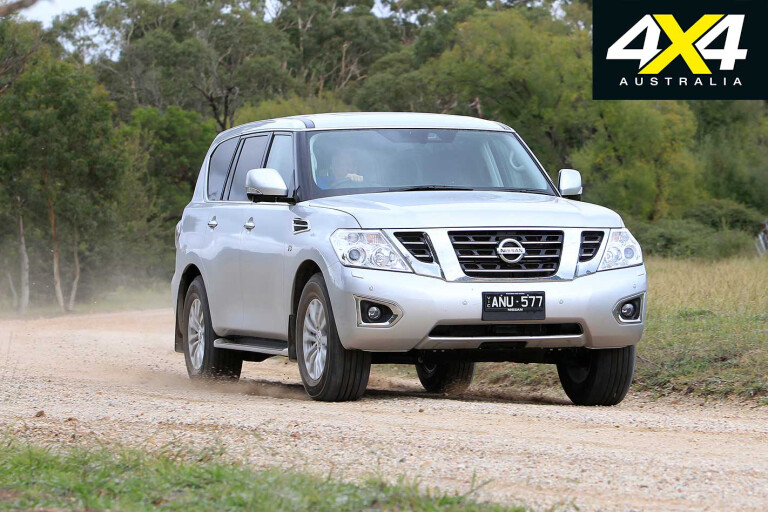
All this power and performance isn’t lost on a chassis that offers near physics-defying on-road handing. Push the big Patrol as hard as you like and there’s hardly a hint of bodyroll thanks to the brilliant HBMC suspension.
For its size and weight the Y62 is light on its feet (far lighter than the 200) and feels surprising agile, yet at the same time stable. It’s still no Discovery, but then it gives away 600kg and sits higher on the road, so there’s only so much the HBMC can do.
Nice ride comfort, too, no doubt helped by the tall wheel and tyre spec. On its 18s the Y62 has even more sidewall and a bigger overall diameter than the 18s on the 200.
THE REAL KINETIC
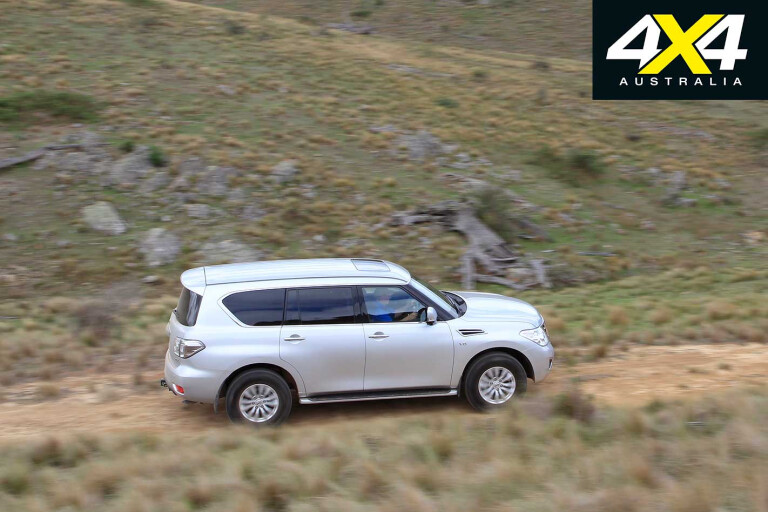
The Y62 Patrol has fully independent suspension and what Nissan calls Hydraulic Body Motion Control (HBMC). Ironically this system is closer to the Western Australia-developed Kinetic system than Toyota’s KDSS, despite Toyota buying the rights to the original Kinetic system.
With HBMC, four hydraulic rams replace the dampers and mechanical swaybars of a conventional suspension system. These rams are interlinked allowing hydraulic fluid – managed by nitrogen-charged accumulators and body motion sensors – to be pumped from one to the other. This allows the wheel travel, body roll, body pitch, ride comfort and overall stability of the vehicle to be controlled, and it’s automatically optimised for both on- and off-road driving.
OFF-ROAD
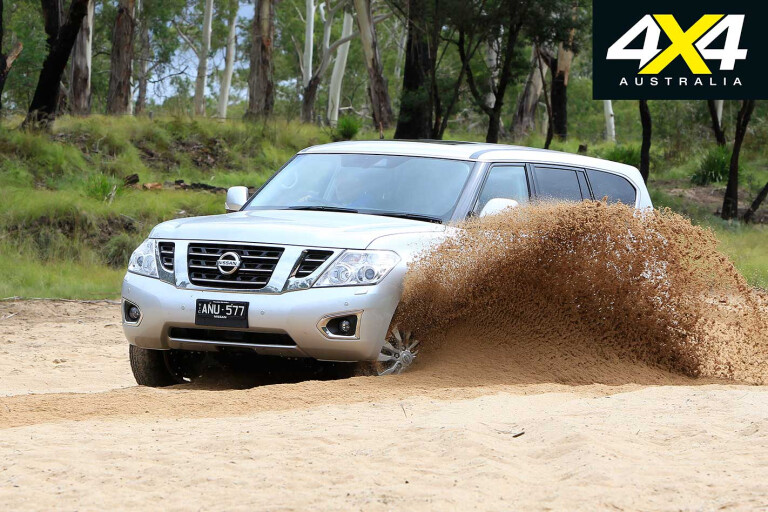
The Y62 has an on-demand 4x4 system (rather than a full-time system), where the default ‘Auto’ mode directs some drive to the front wheels if there’s any traction issues at the rear.
The drive can also be locked 50:50 in 4H mode or with low range selected. There’s also a rear diff lock that can be engaged in either high or low range; although, engaging the locker cancels the traction control on both axles. The driver can also select ‘Sand’, ‘Snow’ or ‘Rock’ modes in both high and low range.
If all this sounds complicated, it’s actually simple to use. What’s more, the Y62 is excellent off-road thanks largely to the HBMC suspension being able to go from taut on-road to supple off-road automatically and instantaneously, due in part to the fact there are no swaybars to limit wheel travel.
Given the HBMC’s sophistication it’s somewhat surprising Nissan didn’t build in a height adjustment feature, as the Y62’s ground clearance could be better despite the 287mm factory claim from Nissan.
CABIN, ACCOMMODATION AND SAFETY

The Y62 has the most spacious and airy cabin in this company and is particularly good in terms of load space – the best here by a good margin – and the space behind the third-row seats when they’re deployed. It also features the widest second-row seat among these three; although, the third row isn’t as adult-friendly as the Discovery.
The Y62 has a high quality but overstated – lots of chrome – dash and cabin finish. Did someone say “a bit like a Haval?” The Ti-L, like the other two wagons here, seats seven; although, the lower-spec Ti seats eight. The Y62 doesn’t have an ANCAP safety rating as it hasn’t been submitted for safety testing, which isn’t mandatory in this country.
PRACTICALITIES

THE Y62 has the highest Gross Combined Mass of the three wagons: a mighty 7000kg, which is testament to its size if you even needed convincing. The Y62 is also rated to tow 3500kg and would no doubt do that with ease, even if thirsty in the process.
Given its thirst, it’s a good thing it has a decent-sized fuel tank; although, its 140 litres doesn’t take it much farther than the Discovery’s 85 litres. The Y62 asks for premium-grade fuel, but it appears to run satisfactorily on lower-octane fuels including E10 and even 91.
WHAT YOU GET
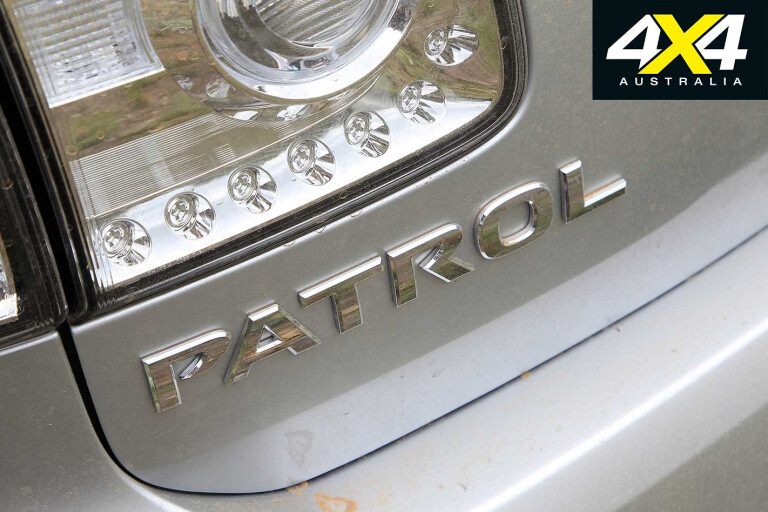
The Y62 Patrol comes in two model grades: the $71,990 Ti and the $88,990 Ti-L. Even the Ti is well-equipped with leather, sunroof, six airbags, eight-way adjustment for the driver’s seat, three-zone climate control, a rear-view camera, sat-nav, parking sensors, auto headlights and wipers, tyre-pressure monitoring, external-view cameras and a rear locker.
The Ti-L adds heated and cooled front seats with memory settings for the driver, rear DVD entertainment, a 13-speaker premium Bose audio system, Xenon headlights, a power tailgate, radar cruise, forward-collision alert, lane departure and blind spot warning, and mitigation systems.
THE VERDICT
The tourer's choice
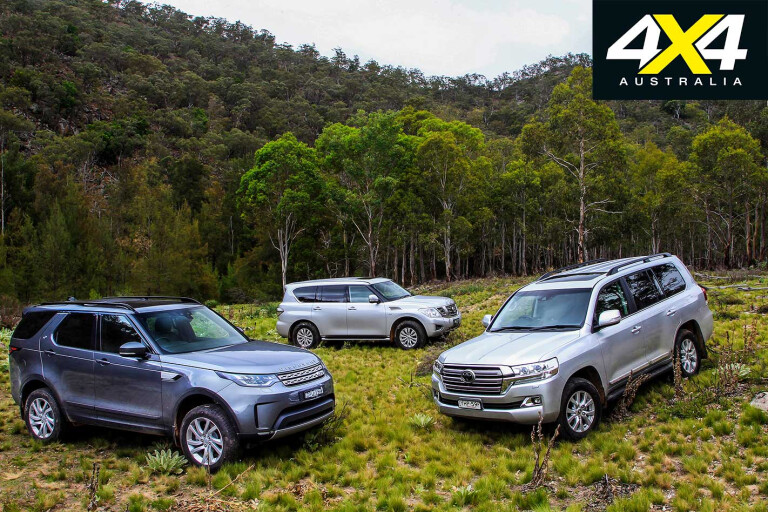
For every Nissan Patrol sold Toyota sells nearly nine LC200s. For every Discovery sold, six LC200s are sold. The market’s preference is clear – it’s 200 all the way.
The Patrol can’t get a look in given the market’s liking for diesel power. After all, Toyota offers a petrol-powered V8 in the 200 and hardly anyone buys it. Perhaps if petrol was cheap, as it is in the Y62’s prime markets (Middle East and USA), things might be different.
It’s a shame really as, fuel-running costs aside, the Y62 has everything else going for it including performance, refinement, cabin space, on-road dynamics, off-road ability, equipment and very sharp pricing. The $30K you save on a Patrol Ti-L over a 200 Sahara will pay for the first 100,000km of premium petrol at current prices, assuming an average consumption of 20L/100km.
With a decent diesel engine from Nissan’s central ‘Alliance’ partner Renault or, better still, technology associate Mercedes-Benz, the Y62 could be brilliant.
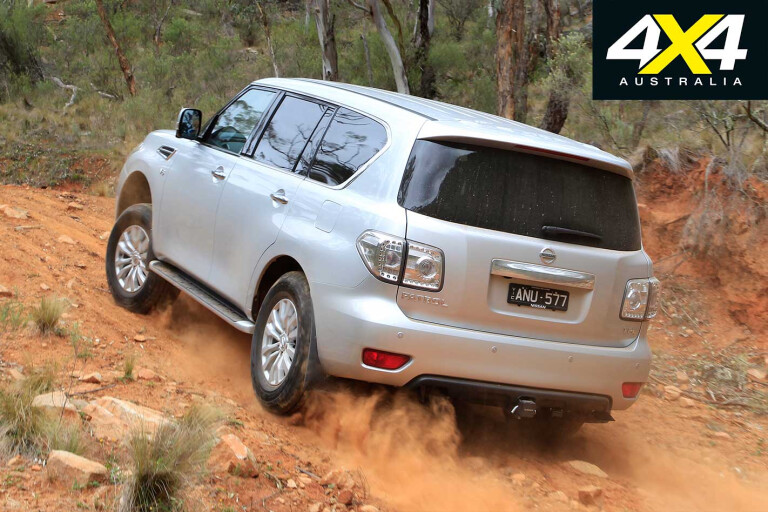
Land Rover’s new Discovery is already brilliant, thanks to its unmatched spectrum of capability. Off-road, the Discovery easily matches the 200 and the Patrol, and it’s even better in situations where ground clearance and wading depth are paramount. At the same time, its off-road dynamics are in a different and better class.
The Discovery is also more efficient. Not just fuel efficiency, but for the fact it’s a big and spacious wagon – close to the 200 inside – that’s also notably fuel efficient. Still, that fuel efficiency isn’t sufficient to overcome the modest fuel capacity, one of the major shortcomings of the Discovery if you’re looking to buy a remote-area tourer. Plus, there’s not much point looking at the aftermarket for a long-range tank or a bullbar.
The only good news with this new Discovery in terms of bush practicality is that, for any given wheel size, there’s more tyre than with the Discovery 4. The smallest factory rim remains 19 inches, but given the brakes are no bigger than Discovery 4, bespoke 18s will theoretically fit.
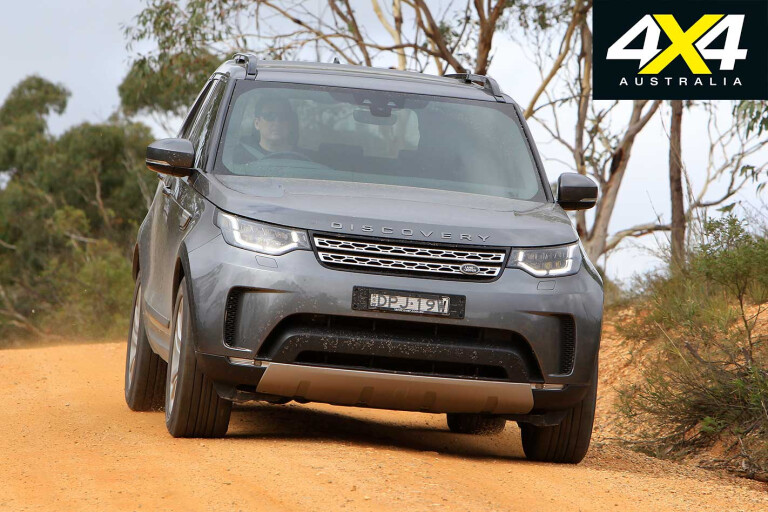
This new Discovery also has sufficient guard clearance to run a one-size-bigger tyre than standard spec, which means readily available 275/75s all-terrains – some in Light Truck construction – can be fitted on a 20-inch rim.
Practicality is, of course, the very last concern you have with a 200 Series. It’s practical enough straight out of the box, yet the support from aftermarket for just about any accessory or enhancement is second-to-none.
Compared to the complex Discovery it’s also simple and conservatively engineered, which is just what you want the farther you get from civilisation. No wonder it’s the market favourite and the first pick if you wish to go bush.
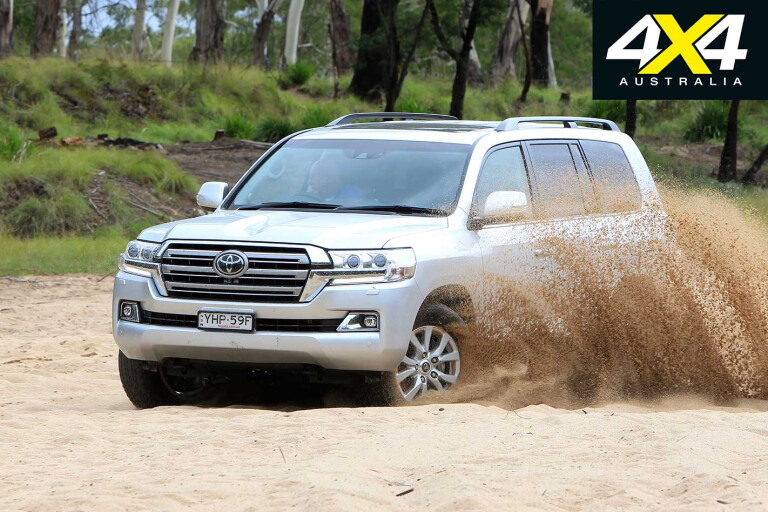
Acknowledgement
Many thanks to Great Divide Tours for the use of its ever-improving 4x4 testing and training facility near Braidwood in the NSW Southern Tablelands. See more at www.4wd.net.au.
SPECS
| 2018 Land Rover Discovery TD6 HSE | 2018 Toyota Land Cruiser Sahara | 2018 Nissan Patrol Ti-L | |
| ENGINE | 3.0-litre V6 turbo-diesel | 4.5-litre V8 twin-turbo diesel | 5.6-litre DOHC V8 petrol |
| POWER | 190kW at 3750rpm | 200kW at 3600rpm | 298kW at 5800rpm |
| TORQUE | 600Nm at 1750-2250rpm | 650Nm at 1600-2600rpm | 560Nm at 4000rpm |
| GEARBOX | Eight-speed automatic | Six-speed automatic | Seven-speed automatic |
| 4X4 SYSTEM | Dual-range full-time | Dual-range full-time | Dual-range on-demand |
| CRAWL RATIO | 44.34:1 | 34.1:1 | 43.9:1 |
| CONSTRUCTION | Monocoque | Separate-chassis | Separate-chassis |
| SUSPENSION (front) | Independent/air springs | Independent/coil springs | Independent/coils + HBMC |
| SUSPENSION (rear) | Independent/air springs | Live axle/coil springs | Independent/coils + HBMC |
| KERB WEIGHT | 2223kg (five-seat) | 2740kg | 2842kg |
| GVM | 3050kg (five-seat) | 3350kg | 3450kg |
| PAYLOAD | 827kg (five-seat) | 610kg | 608kg |
| TOWING CAPACITY | 3500kg | 3500kg | 3500kg |
| GCM | 6650kg (five-seat) | 6800kg | 7000kg |
| FUEL TANK | 85 litres | 138 litres | 140 litres |
| ADR FUEL CLAIM | 7.2L/100km | 9.5L/100km | 14.4L/100km |
| TESL FUEL USE | 12.2L/100km | 14.3L/100km | 19.2L/100km |
| TOURING RANGE* | 647km | 915km | 679km |
*Based on test fuel use, claimed fuel capacity and a 50km ‘safety’ margin.
OFF-ROAD CAPABILITIES
| Land Rover Discovery | Toyota Land Cruiser 200 | Nissan Y62 Patrol | |
| Departure Angle | 30º | 24º | 26.2º |
| Rampover Angle | 27.5º | 21º | N/A |
| Approach Angle | 34º | 32º | 34.1º |
| Wading Depth | 900mm | 700mm | N/A |
| Ground Clearance | 283mm | 230mm | 287mm |
PRICES*
| Land Rover Discovery | Toyota Land Cruiser 200 | Nissan Y62 Patrol |
| TD6 S (five-seat): $78,750 | GX: $78,261 | Ti: $71,990 |
| TD6 SE (five-seat): $92,650 | GXL: $88,541 | Ti-L: $88,990 |
| TD6 HSE (five-seat): $103,000 | VX: $98,881 | |
| TD6 HSE Luxury (5-seat): $116,800 | Sahara: $120,301 |
*Prices do not include on-road costs

COMMENTS